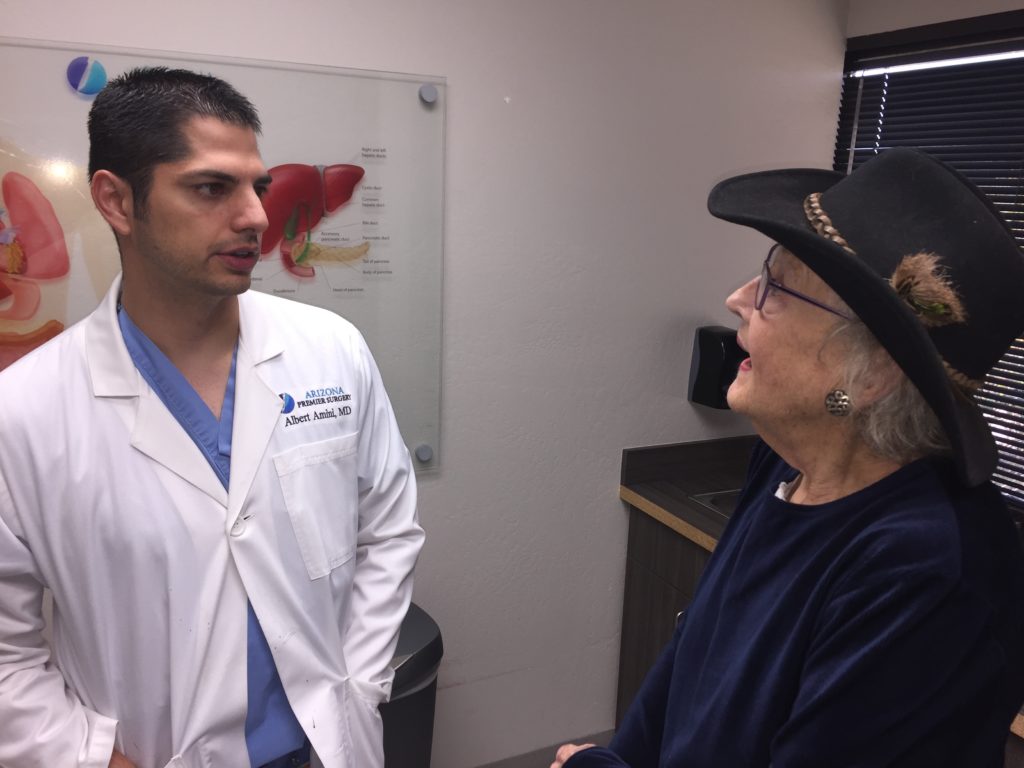
By Deborah Hilcove
Decked out in her red cowboy boots and black Stetson, retired goldsmith Dale Connors looks the part of a pioneer. But the Chandler resident isn’t that kind of pioneer. Instead, she’s the first person in Arizona to undergo a totally robotic-assisted procedure to remove a mass involving the pancreas, bile duct and stomach.
Connor’s road to local fame began benignly in January of 2018 with an unresolved bladder infection.
An infectious disease specialist at Chandler Regional Medical Center ordered a series of tests, focusing on the gastrointestinal tract. He diagnosed salmonella and began an antibiotic regimen which cleared the infection.
However, imaging showed a partially blocked bile duct and a suspicious pancreatic mass.
While not all masses are malignant cancers, pancreatic tumors need to be checked. Connors was referred to Dr. Albert Amini, a general surgeon at Chandler Regional who specializes in pancreatic and hepatobiliary procedures.
However, since the salmonella infection was cleared and she had no other symptoms, Connors delayed further appointments until, she said, “My husband nagged me into seeing Dr. Amini. That was in July. Dr. Amini told me he couldn’t tell if the problem was cancer or not, but because of the blockage and some other suspicions, he’d need to remove part of the bile duct, the pancreas and some of my stomach.”
A major concern was that the mass might be malignant.
Because there are few identifiable symptoms in the early stages of pancreatic cancer, it’s called the “silent disease,” sometimes taking years before causing pain and pressure.
Currently, surgery is the most effective treatment for removing a suspicious pancreatic tumor. Amini recommended a Whipple resection, named for Columbia Hospital doctor Allen O. Whipple, who first performed the complex surgery in 1935.
Conventional open surgery requires a large incision, typically 12 to 15 inches across the belly. A more recent development is minimally invasive and performed through small incisions that allow a tiny camera and surgical instruments to be used.
In either procedure, the abdominal organs are connected, increasing the complexity of the lengthy procedure and possibly requiring a blood transfusion.
Connors says:
“Dr. Amini drew pictures for me and described the types of Whipple procedures, both open and laparoscopic. He stated the conventional open Whipple would take up to four months to recover. I couldn’t imagine waiting that long to recover and get back to my normal routine.
“Then he told me about the robotic Whipple and its advantages. I asked him to show me pictures of the apparatus he’d be using, and he showed how he’d done the robotically-assisted surgery on a pig. It was just amazing to see how he manipulated the little arms and fingers. Just amazing.”
Pausing just a moment, she adds, “When he asked how I felt about being the first Arizona patient to have a totally robotically assisted Whipple procedure, I felt very proud and pleased he thought I’d be a good candidate for the robotic Whipple—that even though I was eighty, he’d take a chance on me.”
The three da Vinci Surgical Systems at Chandler Regional have been used for minimally invasive surgeries for some time, but Amini performed the East Valley’s first totally robotically assisted Whipple surgery on Connors.
Summarizing the advantages, Amini says:
“With the totally robotic Whipple procedure, patients are going home up to a week earlier than if they had the traditional open or a partially robotic procedure. Their overall recovery time is cut in half.”
Said Connors:
“It was a seven-hour surgery….I had very minimal pain for two days post-op, but zero pain since. I was only in the hospital for two weeks total. I was very fortunate. There was no cancer.”
And, she added: Dr. Amini is a delightful man. He did a great job.”

